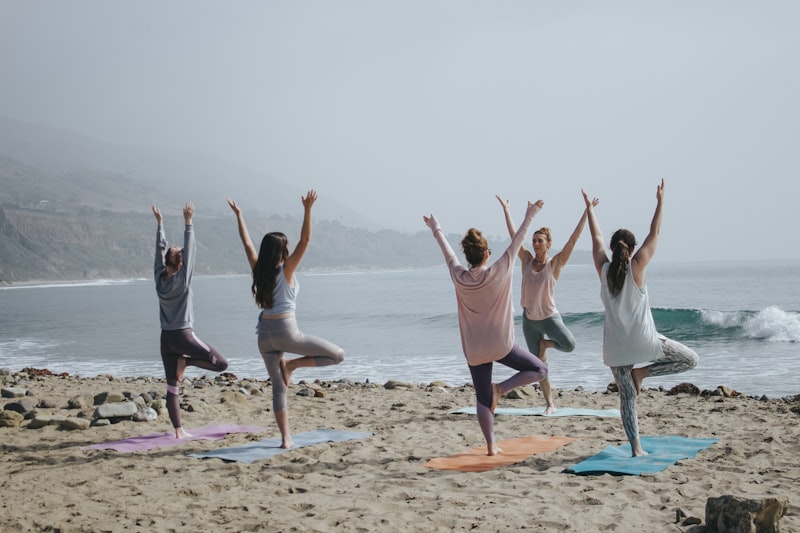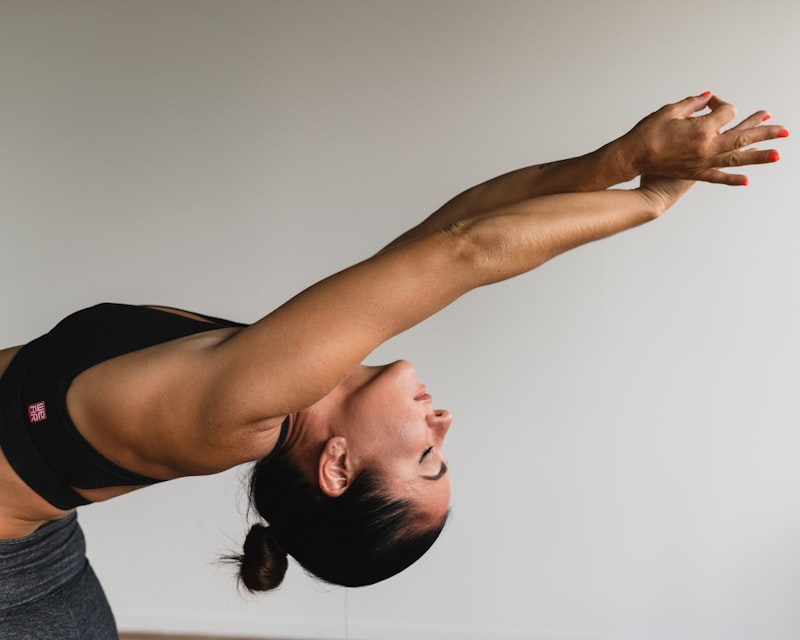Yoga isn’t just about striking poses on a mat—it’s a holistic practice that combines physical postures, breathing exercises, and mindfulness techniques. When used intentionally, yoga can be a game-changer in managing stress and boosting resilience.
So, how exactly can you use yoga to enhance your stress resilience?
Firstly, let’s talk about the physical aspect. Yoga postures, or “asanas,” are designed to stretch and strengthen the body. When you practice these postures, you release tension stored in your muscles and improve overall flexibility. This physical release can directly counteract the physical symptoms of stress, such as tight shoulders or a clenched jaw.
Beyond the physical, yoga places a strong emphasis on breath awareness. Techniques like deep belly breathing or “pranayama” help activate the body’s relaxation response. By slowing down your breath and focusing on its rhythm, you signal to your nervous system that it’s safe to relax, reducing the production of stress hormones like cortisol.

Another key component of yoga for stress resilience is mindfulness. During yoga practice, you’re encouraged to be fully present in the moment, observing sensations in your body and the fluctuations of your mind without judgment. This mindfulness practice cultivates a mental resilience that allows you to navigate stressful situations with greater ease and clarity.
Imagine yoga as your personal stress-busting superhero, equipping you with the tools to face life’s challenges head-on. Just as a superhero relies on their training to conquer villains, you can rely on yoga to conquer stress. Each time you step onto your mat, you’re building not only physical strength but also emotional and mental resilience.
Incorporating yoga into your routine doesn’t have to be complicated. Whether you have five minutes or an hour, carving out time to practice yoga regularly can make a world of difference in your stress resilience. So, roll out your mat, take a deep breath, and let yoga guide you toward a calmer, more resilient you.
Unlocking Inner Peace: Harnessing Yoga Poses to Build Resilience Against Stress
In today’s fast-paced world, stress seems to be an unwelcome companion for many of us. It creeps into our lives through work deadlines, family obligations, and the endless buzz of technology. However, amidst this chaos, there exists a profound antidote that has been practiced for centuries: yoga.
Yoga is not just a physical exercise; it’s a holistic approach to harmonizing mind, body, and spirit. One of its most remarkable benefits is its ability to combat stress and cultivate resilience. How does it achieve this? Through the artful practice of yoga poses, or asanas, which are designed to stretch, strengthen, and balance the body while calming the mind.
Imagine yourself in a serene yoga studio, guided by a soothing voice, as you flow from one pose to another. Each pose, whether it’s the grounding Mountain Pose (Tadasana) or the rejuvenating Child’s Pose (Balasana), has a specific role in helping you release tension and build mental fortitude. These poses not only increase flexibility and muscle tone but also stimulate the parasympathetic nervous system, triggering a relaxation response that counters the effects of stress hormones.
As you hold a Warrior Pose (Virabhadrasana) or twist into a gentle Seated Twist (Ardha Matsyendrasana), you’re not just engaging your muscles—you’re recalibrating your entire being. The deep breathing inherent in yoga enhances oxygen flow, promoting clarity of thought and emotional stability. It’s like pressing the reset button for your mind, allowing you to face challenges with a renewed sense of calm and resilience.
Whether you’re a seasoned yogi or a curious beginner, incorporating yoga into your routine can be a profound step towards reclaiming inner peace. With consistent practice, these poses become more than just physical exercises; they become anchors of tranquility in your daily life.
Mastering Stress Management Through Yoga: Essential Techniques Revealed
Yoga isn’t just a workout; it’s a holistic practice that blends physical postures, breathing exercises, and meditation. These elements work together to calm the mind and relax the body, making it an effective tool for stress relief. Imagine each pose as a soothing wave washing away tension, leaving you refreshed and centered.
One of the essential techniques in yoga for stress management is controlled breathing, known as pranayama. By focusing on deep, deliberate breaths, you can slow down your heart rate and quiet racing thoughts. It’s like pressing the reset button for your mind, allowing you to approach stressful situations with a clear perspective.
Another key aspect of yoga is mindfulness meditation. This practice encourages you to be present in the moment without judgment. Through regular meditation, you can train your mind to let go of worries about the past or future, fostering a sense of calm and acceptance in the present.
Incorporating yoga into your daily routine doesn’t have to be daunting. Start with simple poses like Child’s Pose or Cat-Cow Stretch, focusing on your breath as you move through each posture. Over time, you’ll build strength and flexibility while cultivating a greater sense of inner peace.
The beauty of yoga lies in its adaptability. Whether you’re a beginner or seasoned practitioner, there’s always room to grow and deepen your practice. With consistent effort, you’ll find yourself better equipped to handle life’s challenges with grace and resilience.
So, if stress has been weighing you down, consider exploring the transformative power of yoga. It’s more than just a workout – it’s a journey towards a calmer, more balanced life. Discover the essential techniques of yoga today and embark on your path to mastering stress management.
Yoga as a Shield: Strengthening Your Mind Against Stress
Yoga, with its origins rooted in ancient India, offers more than just a series of poses. It encompasses a philosophy that integrates breath control, meditation, and physical postures to achieve mental clarity and emotional stability. Imagine yoga as a shield you can wield against the daily onslaught of stressors, protecting your mind and spirit with each mindful breath and deliberate movement.
At its core, yoga teaches us to synchronize our breath with movement, fostering a profound connection between mind and body. This synchronization is key in activating the body’s relaxation response, counteracting the fight-or-flight response triggered by stress. By practicing yoga regularly, individuals can cultivate resilience to stress, enhancing their ability to navigate challenges with calm and composure.
Moreover, yoga acts as a sanctuary where one can retreat from the chaos of daily life. Each session becomes a sacred space to recalibrate, allowing practitioners to release tension stored in their bodies and minds. It’s akin to equipping oneself with an armor that not only shields but also strengthens from within, building a resilient mindset that can withstand the pressures of modern living.
Furthermore, the benefits of yoga extend beyond the mat. Studies have shown that regular yoga practice can lower levels of cortisol, the primary stress hormone, in the body. This reduction not only alleviates immediate feelings of anxiety but also contributes to long-term mental well-being. It’s like forging a shield that grows stronger with each session, reinforcing your mind against the corrosive effects of stress.
From Mat to Mind: Integrating Yoga Practices for Lasting Stress Relief
Yoga isn’t just about stretching on a mat—it’s a holistic practice that intertwines physical postures with mindful breathing and meditation. This ancient discipline offers more than just a workout; it’s a pathway to inner peace and stress management that lasts beyond the yoga session itself.
Imagine stepping onto your mat after a hectic day. As you flow through gentle poses like Downward Dog or Child’s Pose, your body starts to unwind. But it’s not just your body; your mind follows suit. The controlled breathing exercises, known as pranayama, help calm the nervous system. With each inhale and exhale, tension dissipates, making room for a sense of tranquility.
This isn’t just anecdotal; science backs it up too. Studies show that regular yoga practice can lower cortisol levels—the hormone responsible for stress—leading to a more balanced emotional state. It’s like giving your mind a refreshing break amidst life’s chaos.

The beauty of yoga lies in its adaptability. Whether you’re a beginner or seasoned practitioner, there’s a style that suits your needs. From vigorous Vinyasa flows that get your heart pumping to gentle Yin sessions that encourage deep relaxation, there’s something for everyone on the yoga spectrum.
But yoga is more than just a physical practice; it’s about mindfulness too. When you’re fully present on the mat, focusing on your breath and the sensations in your body, worries about the past or future fade away. It’s a moment of pure presence—a mini-vacation for your mind.
Incorporating yoga into your routine doesn’t require hours of dedication. Even a few minutes a day can make a significant difference in how you handle stress. Think of it as a tool you carry with you, ready to use whenever life gets overwhelming.
Frequently Asked Questions
Can Yoga Help with Mental Resilience as Well as Physical Health
Discover how yoga enhances mental resilience alongside physical health through a concise exploration of its holistic benefits and practices.
What Should I Consider When Choosing a Yoga Class for Stress Management
When choosing a yoga class for stress management, consider the instructor’s experience in teaching stress-relief techniques, the class format (such as gentle or restorative yoga), and the location and schedule that fit your routine. Look for classes that emphasize relaxation, deep breathing, and mindfulness practices to effectively manage stress levels.
How Often Should I Practice Yoga to Reduce Stress
Discover how frequently practicing yoga can effectively reduce stress levels. Learn the optimal frequency and duration of yoga sessions to achieve maximum stress-relief benefits.
Are There Specific Breathing Techniques in Yoga for Stress Relief
Discover effective breathing techniques in yoga specifically designed to alleviate stress. Learn how these methods can calm the mind and body, promoting relaxation and emotional balance.
What are the Best Yoga Poses for Stress Resilience
Discover effective yoga poses that promote stress resilience. Learn poses like Child’s Pose for relaxation, Downward Facing Dog for calming the mind, and Bridge Pose for reducing tension. These poses help build mental and physical resilience to stress, fostering a sense of calm and balance.


